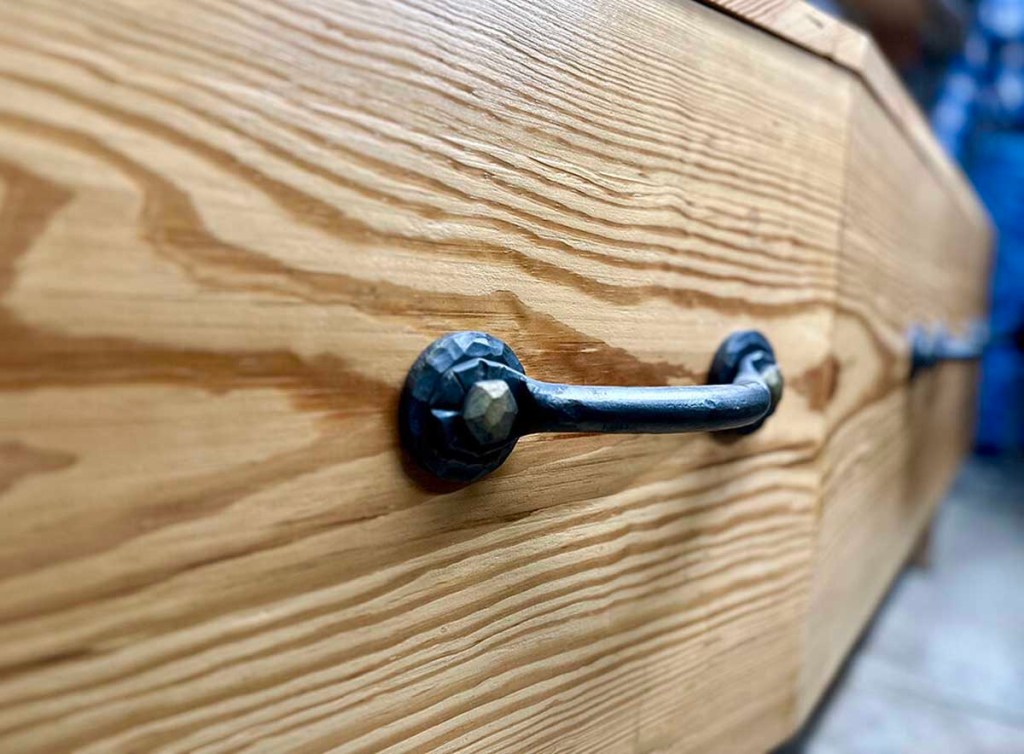A simple pine box: Dr. Bill Peinhardt put his woodworking skills to practical use.
Published 12:15 am Saturday, September 28, 2024

- Sturdy iron handles crafted by local blacksmith Allan Kress are affixed to the outside of Peinhardt’s coffin.
Bill Peinhardt might possess a lifetime’s knowledge of medicine, but don’t ask him to distinguish between a casket and a coffin.
“I don’t know the difference!” says the well-known retired physician and lifelong Cullman native. “Those terms may be interchangeable; I’m not sure. I do know the thing they put it in is called a ‘vault.’ I don’t really like the idea of that, because as far as I’m concerned, I’d be happy to just put it in the dirt and let it all go back to nature.”
In fairness to Dr. Peinhardt, until we dug in to find out why Peinhardt — a gifted woodworker with a well-equipped basement wood shop — decided to build his own coffin (the proper term, as it turns out), we didn’t know the difference either. A casket is what you’re likely to see at the majority of present-day funerals: big, rectangular, fitted with a hinged lid split so that the lower part of a body can remain covered while the head and torso are still visible.
Bill’s bespoke burial vessel, though, is far less fussy, and conforms to the conventional description of a “coffin.” It’s made of pine, it’s got a one-piece lid that someone (not Peinhardt) will have to nail shut with handmade iron nails, and it has six sides instead of four: Just like the coffins you’ve seen in old Golden-Age horror movies about vampires, it’s widest at the shoulders, but tapers inward at slight angles toward the feet and head.
For the past 10 or 15 years (He can’t quite remember when he finished it), Peinhardt’s coffin has been awaiting its yet-unknown appointed date with usefulness by occupying a nook in his Cullman basement. Peinhardt and his wife Carolyn have long gotten used to having it around, though, as he notes with a laugh, it definitely has a way of catching the surprised eye of unprepared visitors.
“Particularly the pest control people — they’ve definitely been startled by it if it’s their first time in the house!” Peinhardt jokes.
His coffin is a modest and simple exemplar of his considerable woodworking skills, and he’s the first to confess that he didn’t build it to test the limits of his craftsmanship. “No,” he muses, “it wasn’t hard to build. Just getting the angles straight on the sides was probably the most challenging thing about it.”
But despite its unpretentious design, Peinhardt’s handmade coffin is an elegant and well-made artifact of local ingenuity, affixed with sturdy iron handles crafted by local blacksmith Allan Kress (who also fashioned the iron nails), and appointed on the inside with a suitably cozy silken lining courtesy of the upholstery department at Wallace State Community College.
Peinhardt wanted his coffin kept simple. “You look at the different styles — some are quite fancy and ornate,” he says. “But I wanted to go back to what was done a long time ago, which was just a simple pine box. I can’t remember at this point whether I got that design from somewhere or if did it on my own. But it’s traditional — it’s what you think of as a ‘coffin.’ The pine is local. I sawed it at the sawmill at the [Peinhardt Living History] farm.”
Even though he’s built furniture that shows off the more delicate side of his woodworker’s skill, he’s clearly not hung up on artistic pretense when it comes to crafting his own burial box. Like the many rustic bird houses he’s made and gifted to friends, it’s meant to be functional and unassuming in its appearance — a nod to an earlier and different era, when sheer necessity compelled people to build this sort of thing when unfortunate circumstances demanded it.
“You look far back enough into the more rural times, obviously when somebody died, they’d have to nail them together a coffin,” he says. “What’s sad is if you come across a child’s coffin that someone has made in the past. Because back in the old days, they would have had to make that child’s coffin — and they would have had to make it to size.”
For all the toil and care that must’ve gone into making it, Peinhardt has to pause and think for a second about what compelled him to join the thin ranks of the few local craftsmen who’ve endeavored to construct their own coffins in the first place.
“That’s a hard one to answer,” says Peinhardt, now 77, who’s seven years into retirement from a physician’s career that spanned 40 years. “Being in medicine, you quickly come face to face with the fact that we’re all going to die. and just thinking about my own death, it was like, ‘I’d like to be prepared and build my own coffin.’”
For Peinhardt, it really is that simple — but he’s definitely not dogmatic about evangelizing the whole DIY-coffin idea to anybody else. Asked if the rest of his family has lined up to have him build their coffins, too, he just chuckles. “Nobody’s asked!” he teases. “Beyond the coffin, in fact, I have not made any plans at all about my funeral. I have two daughters living here in town — they can take care of it!”





